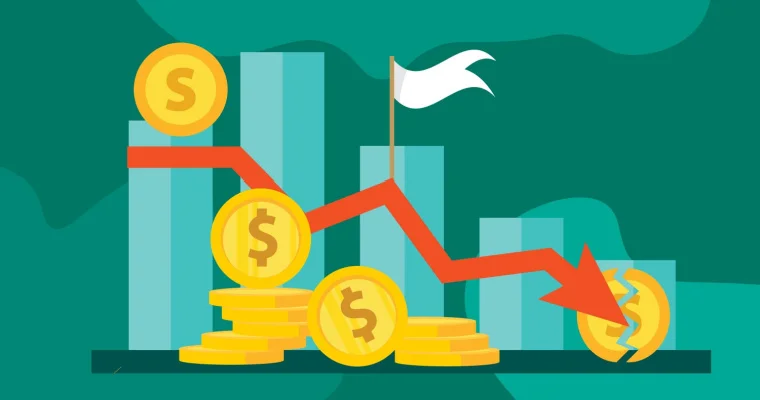What is Sunk Cost – Its Examples, Types, Sunk Cost Bias and Fallacy

Sunk cost is a type of cost that a business incurs that the businesses cannot recover. These costs do not form a part of analysis and future decision-making. However, in reality, some businesses may consider these costs as it is psychologically difficult to throw away time and money invested even though outcomes may not be according to expectations.
This article discusses everything you need to know about sunk cost – from its types and examples to sunk cost fallacy, sunk cost bias and more. Read on!
Types of Sunk Cost
Some types of sunk costs that businesses usually face have been discussed below:
1. Research and Development (R&D) Costs
Any enterprise will incur these costs while they are working on building a new prototype. All expenses related to experiments, logistics, and infrastructure are considered to be sunk costs.
2. Advertising and Marketing Costs
This is another type of sunk cost that a business incurs when it is about to launch a new product or rebrand itself. These are primarily publicity and marketing costs for new products.
3. Integrating New Software
Installing or integrating new software for better functioning of the company will lead to some costs. Any software update or adoption of new technology will lead to several benefits, but it comes at a cost that cannot be recovered.
What Are Examples of Sunk Costs?
Some sunk cost examples have been discussed below to offer a clearer picture of the concept:
Let’s say you are running a multi-cuisine restaurant in a Tier 2 city, and you wish to become a leading food outlet in that city. However, you are facing severe competition from old restaurant chains that have a firm foothold in that city.
Now, as part of an aggressive bid to become the No. 1 food chain, you have decided to launch new food items which have been prepared by renowned chefs of the region.
In order to make people aware of the new development, you embark on a massive publicity drive across online and offline platforms. This publicity blitz has cost you Rs. 1 lakh. This cost will become sunk costs for your company.
Now, you might wonder if publicity will drive people to visit the restaurant, which will lead to profits, how come the expenses become a sunk cost?
Well, in spite of the potential revenues that the restaurant may earn, it cannot directly recover costs incurred on marketing. The publicity will lead to revenue generation in an indirect way, and therefore, the expenses will come under sunk costs or embedded costs.
What is Sunk Cost Fallacy?
The sunk cost fallacy occurs due to the improper business and strategic mindset of owners and management. Every financial decision related to business involves the utilisation of resources.
Managers feel like going ahead with a certain decision even though the said decision may not lead to expected benefits or gains for them.
The reasoning behind going ahead with such projects is that they have invested a lot of time, energy, and monetary resources and going back will lead to complete wastage of them. Owners feel that if they continue to invest and change certain dynamics, it may lead to a quick reversal for them.
Due to this reasoning, enterprises pump more money into that project. However, in case the plan does not materialise, the amount of loss could be a lot higher than the previous reading.
According to behavioural economists, sunk cost fallacy occurs because emotions can overpower rational decision-making ability. Abandoning a project, plan or decision after investing in them can lead to feelings of negativity or guilt among owners or management.
Therefore, economists always advise entrepreneurs, especially new-age or novice ones, to avoid considering sunk costs while evaluating any project. If they consider this, it may exacerbate their losses.
Example of a Sunk Cost Fallacy
Let’s understand this concept with the help of a real-life example.
Suppose your favourite football club has purchased a star striker for USD 150 million.
However, he is not playing according to expectations and giving sub-optimal results. However, considering the price tag, the club manager is starting with him in every league game and benching other deserving players who are playing well in practice sessions.
This scenario is a sunk cost fallacy whereby past actions and investments are guiding future decisions leading to below par results for the team.
What is Sunk Cost Bias?
Have you ever faced a situation when you continue reading a novel even though you find the topic boring? Or stayed with an investment decision because you have invested your resources in it? If your answer is yes, you have experienced sunk cost biases.
It is the basic psychological tendency of humans to stay put in a decision and invest additional resources in an unprofitable venture because of the time and resources invested in them. It usually occurs when you do not wish to admit or face losses due to your decisions.
How Can Sunk Cost Impact Product Management?
Product managers play an integral role in developing a new product or a feature in an existing product. They supervise and motivate their team members for successful launching of the same. However, the sunk cost fallacy can hamper their rational thinking and lead to unsustainable decision-making.
Even after realising that certain products or new features may not achieve their end goals, they tend to go ahead with the project because of resources invested in the same. It becomes challenging for managers to come to terms with the fact that their investments will be sunk costs and, thus, not recoverable.
What Are the Differences between Sunk Costs and Relevant Costs?
Here are some key differences between the two costs:
| Parameter | Sunk Cost | Relevant Cost |
| Meaning | These relate to expenses incurred that are not recoverable. | These are future expenses which the company may incur. |
| Effect | It should not be considered while taking any future business decision. | Relevant costs are an integral part of future decision-making. |
| Examples | Marketing expenses and research and development costs. | Product pricing and inventory purchases. |
Final Word
Sunk cost is an economic concept that represents unrecoverable expenses. It is a type of fixed cost that should not go into consideration while evaluating a project or taking any future course of action. Businesses should understand that it is not a relevant cost for decision-making, and they should avoid such costs as they are unrecoverable.
FAQs
Ans: It is an implicit cost that represents the foregone potential gains of the next best alternative. Suppose you have completed your graduation and are in a dilemma about whether to go for Masters or take up a job, and you receive a job offer with an annual pay scale of Rs.5 lakh.
However, you decide to pursue Masters and forgo the job. Therefore, the opportunity cost of doing a master’s would be equivalent to Rs.5 lakh.
Ans: Some factors that may lead to sunk cost fallacy in decision-making include overoptimistic biases, wastefulness, loss aversion and framing. All these may eventually influence companies to throw good money for bad to cut losses.
Ans: There are some strategies that you may incorporate in your decision-making to avoid this fallacy. These are focusing on desired objectives from the project and reviewing these plans or projects at regular intervals. Moreover, you should be ready for any uncertainty coming from your decision.
Ans: It is an important economic concept for business houses. They should avoid this while making any future decisions because they will incur this cost regardless of whether they decide to abandon the project or go ahead with it. It is important to keep sunk cost aside as incorporating it in the decision-making process may lead to unsustainable decisions.
Disclaimer
This article is solely for educational purposes. Navi doesn't take any responsibility for the information or claims made in the blog.

Customer’s Feedback
No comments found.What is Primary Deficit? – Example, Formula & Measures
What is a Primary Deficit? Primary Deficit is the difference between the current year’s fiscal... Read More »What is Financial Ratio Analysis? – Objectives, Types and Uses
Ratio analysis is a process that allows people to assess the financial health of a company. Using t... Read More »Treasury Management – Its Functions, Types and Benefits
Even the most well-funded business can run into huge losses if it does not have the resources to fu... Read More »How Anti Money Laundering Combats Financial Crime?
Anti Money Laundering (AML) is a system of rules, laws, regulations, and procedures that financial ... Read More »What is Salvage Value and Why is it Useful?
Salvage value, also called scrap value, is the value of a specific asset after its useful life. In ... Read More »Key Difference Between Factoring and Forfaiting in Trade Finance
Factoring and forfaiting have grown in prominence as major sources of export financing. For the uni... Read More »What is Factoring and its Importance in Financial Management?
Factoring is a practice in which a company buys the accounts receivable of another company at a dis... Read More »What is Budget Surplus: Its Effects, Advantages and Impact with Examples
When the revenue of a government, business, or individual exceeds its expenses in a given period, i... Read More »What is Balanced Budget – Components, Importance and Examples
In financial planning or the budgeting process, a balanced budget is one in which total anticipated... Read More »What Does Inflationary Gap Mean in Macroeconomics?
In macroeconomics, the difference between current and potential GDP is known as a gap. This gap is ... Read More »What is Accounting Conservatism in Finance and How Does it Work?
Accounting conservatism involves a conservative set of accounting guidelines wherein the worst-case... Read More »Multiple Linear Regression (MLP) – Uses, Formula and Examples
Various statistical models help in establishing a relationship between different variables. Multipl... Read More »Top 10 Chit Fund Schemes in India in 2023
Chit funds are one of the most popular return-generating saving schemes in India. It is a financial... Read More »10 Best Gold ETFs in India to Invest in April 2023
Gold ETFs or Gold Exchange Traded Funds are passively managed funds that track the price of physica... Read More »10 Best Demat Accounts in India for Beginners in 2023
Creation of Demat accounts revolutionised the way trades were conducted at the stock exchanges. It... Read More »20 Best Index Funds to Invest in India in April 2023
What is an Index Fund? An index fund is a type of mutual fund or exchange-traded fund (ETF) that... Read More »Best Arbitrage Mutual Funds to Invest in India in April 2023
Arbitrage funds are hybrid mutual fund schemes that aim to make low-risk profits by buying and sell... Read More »10 Best SIP Plans in India to Invest in April 2023
What is SIP? SIP or Systematic Investment Plan is a method of investing a fixed amount in ... Read More »10 Best Corporate Bond Funds in India to Invest in April 2023
Corporate bond funds are debt funds that invest at least 80% of the investment corpus in companies ... Read More »10 Best Bank for Savings Account in India [Highest Interest Rate 2023]
Savings account is a type of financial instrument offered by several banks. It lets you safely depo... Read More »






























